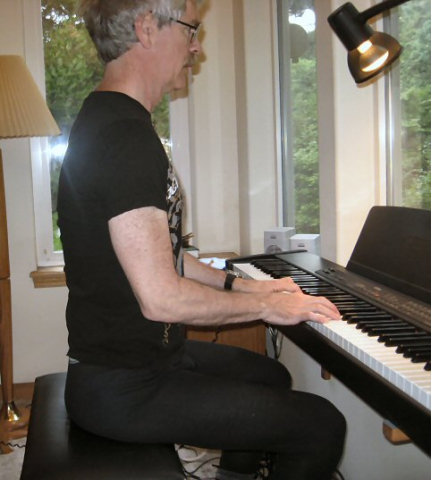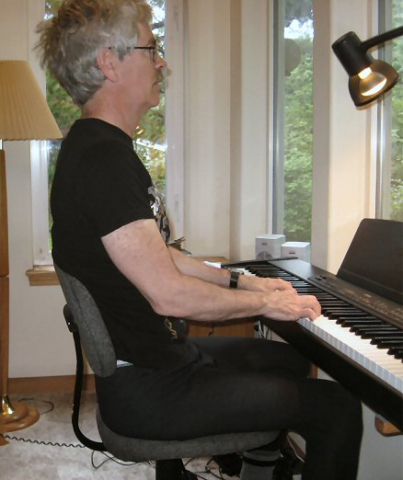It's amazing that you are able to answer questions like this, thanks!
I'm trying desperately to get back to playing piano without pain. I strained my back recently, as I do every few years despite good core strength. I've got your book, and am trying to implement stacksitting. Although I feel like I'm sitting pretty well (see photo), I still get sore (lower back pain) after even a few 10 minute sessions at the piano. I need to be able to play at three-hour gigs, and practice for several hours per day. Perhaps I'm not waiting long enough for my recent strain to heal. The photos below show me stacksitting, stretchsitting (which doesn't seem completely practical for piano), and playing a year ago.
Any comments you have would be appreciated. Thank you.
Al





5 months 3 weeks ago
04/12/2010 - 6:25pm
Hi, adding my two cents here.
Esther's book solved my back problem. Your piano post got my attention at once, because looking back in time I think that the main factor in the onset of my back pain was my total inmersion on the keyboard, putting every night more than 2 solid hours, with bad posture, like for 3 years!. Now I can sit for long time, straight, no pain (at some time I was testing using a stability ball, which I use as a chair at work now, but it is a real pain for the pedals)
To make a long story short: this sequence of exercises in the link below helped me a lot (in addition to Esther's book and Esther's comments and replies in this forum)
http://www.defrancostraining.com/ask_joe/archives/ask_joe_08-10-03.html#question04
Scroll to the middle of the page where the exercises start Joe D’s “Agile Eight”
Like the man says in the link:
------------------------------------------------------------------------------
If performed 5-7 days a week, I guarantee this simple routine will make a huge difference in how you feel and how you move! This routine can be performed at home before you leave for work, school, practice, etc. Or you can perform it at the gym before training. The bottom line is that there’s NO EXCUSE for not fitting this quick routine into your daily schedule.
Give it a try and thank me later!
Joe D.
-------------------------------------------------------
I got to the above link from Mark Sisson's website www.marksdailyapple.com (Mark is a fan of Esther!)
Hope this helps - it surely helped me!
12 years 9 months ago
02/05/2012 - 10:04am
Hi Al,
I see this post is months old, and maybe this is too little too late, but I have some comments. First, be it known that I am not trained in the Gokhale Method, merely a student myself, so please take this with a grain of salt. Just some observations.
Your back appears ramrod straight but not sure your pelvis is adequately anteverted. Your behind is not particularly behind you. But there's always a problem with photos - which capture only a static moment.
As a general observation, musicians are usually in one of two camps, those who play instruments in a fairly static position (classically trained?) and those who play their instruments as if with their whole body. Truthfully, it does not make any difference to the music itself, but I do feel that those who play with their whole body often look much more relaxed. By "whole body" I mean as they play their whole body is inclined to be in gentle swaying motion. In the context of piano playing, these musicians are inclined to periodically roll their pelvis forward (gently) and also roll from one buttock to the other as they go from one side of the keyboard to the other. Again, it seems to me, though it makes no difference to the music and there are "masters" in both camps, there is more health in motion than in static positioning. Just like walking is more relaxing and healthful than sitting.
Two suggestions. In order to get a better feel for pelvic anteversion, put some attention on Glidewalking and the feel of your buttocks - alternately - actively propelling you forward. My second suggestion is only applicable if you are indeed a "static" player and it could possibly disrupt your piano playing - temporarily anyway - so be warned, but it would involve tying your upper arms behind your back (as per the book) while you practice playing. It would force you to use your whole body to play. Perhaps only have a loose loop around your upper arms to avoid exaggerated or excessive body lean to the sides - the goal is just a gentle swaying after all.
3 years 9 months ago
12/15/2010 - 7:51am
Hi Al,
Thanks for the pictures! I'm so glad you are exploring Stacksitting while playing the piano. I've had many students who are pianists and it has helped them trememdously. Yes, Stretchsitting would be an easy fix, but I realize it is just not practical for playing most pieces. The first photo shows a nice straight back, but it looks like you are straining a bit by using your back muscles to keep you upright. I would encourage you to use a wedge or move much closer to the edge of the bench to really help your pelvis tip forward or "antevert." If you use the edge of the bench, you may want to line it with a blanket, towel, or flannel sheet since the wood can be a bit hard for the Sitz bones.
I've seen some piano benches that actually tilt forward which can solve a lot of these issues.
Your Stretchsitting looks great by the way! Much improved from photo #3. You may want to lengthen your neck a bit by letting your chin drop down, which you are doing quite well in photo #1.
I hope this is helpful!
-Charlene Hannibal
Gokhale Method Teacher, Palo Alto/San Francisco